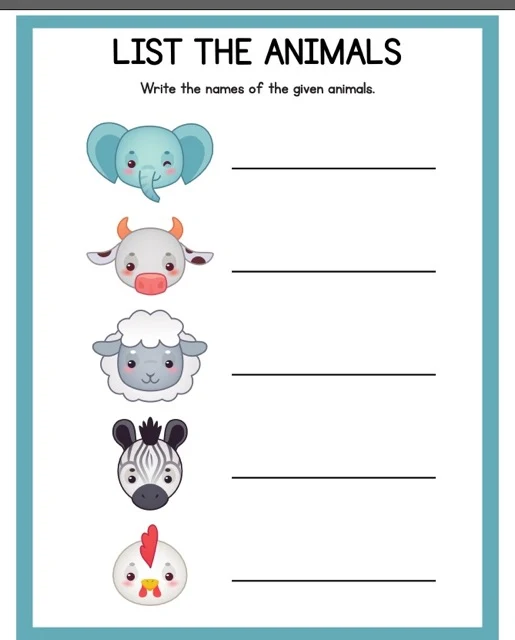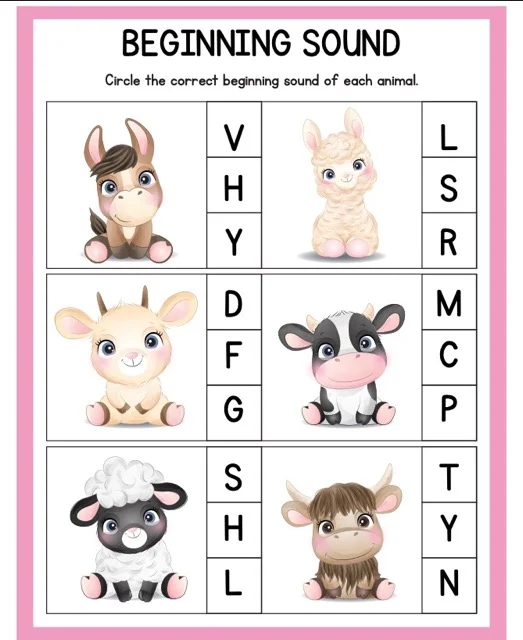Animal-Themed Learning Activities for Young Children
This briefing document summarizes three sources detailing animal-themed learning activities for preschool and early elementary children (ages 3-7). The activities focus on making learning fun and engaging, covering literacy, numeracy, and other essential skills. They are adaptable for classroom or home use, catering to diverse learning styles. Examples include games like mazes, word searches, and counting exercises, all incorporating animal themes. The document highlights the benefits for both educators and parents in promoting early childhood development.
Animal-Themed Learning Activities for Young Children
Briefing Document: Animal-Themed Learning Activities for Young Children
Summary: This document analyzes the value and implementation of animal-themed learning activities for young children based on three source materials: “Animal-Themed Learning Activities for Young Children,” “Animal-Themed Learning: A Study Guide,” and “Testing Theme: Animal Activities.pdf”.
Main Themes:
●
Engagement and Fun in Learning: Animal themes provide a captivating and stimulating context for young children, making learning enjoyable and promoting active participation. “These activities aim to make learning fun and engaging for young children by incorporating animal themes.” (Source 1)
●
Development of Essential Skills: These activities target a wide range of developmental areas, including literacy, numeracy, problem-solving, fine motor skills, and more. (Sources 1 & 2)
●
Versatility and Adaptability: Animal-themed activities are suitable for both classroom and home environments, with varying complexity to cater to different learning styles and skill levels. (Sources 1 & 2)
Key Ideas and Facts:
●
Target Age Group: The activities are primarily designed for preschool and early elementary students, approximately ages 3-7. (Sources 1 & 2)
●
Literacy Skills Development: Activities such as missing letters, matching words, word searches, and spelling exercises enhance letter recognition, spelling, vocabulary, and word-picture association. (Source 1)
●
Numeracy Skills Development: Activities like counting and writing, counting and circling, color by number, and basic addition and subtraction using animal illustrations promote number recognition, counting, and fundamental math concepts. (Source 1)
●
Additional Skills Development: Animal-themed activities also foster problem-solving through mazes and hidden animal activities, fine motor skill development through coloring, tracing, and cutting, and pattern recognition. (Sources 1 & 2)
●
Catering to Learning Styles: The diverse range of activity types caters to visual, kinesthetic, and auditory learners, ensuring inclusivity and effective learning for all children. (Source 2)
●
Benefits for Home Use: Parents can utilize these activities to supplement classroom learning, provide engaging leisure activities, and create focused learning time with their children, strengthening bonds and promoting educational development. (Source 2)
●
Examples of Activities: "Testing Theme: Animal Activities.pdf" visually demonstrates the variety of activities, including:
○
Missing Letters
○
Match the Words
○
Pattern
○
Finish the Pattern
○
Word Search
○
Animal Sudoku
○
Crossword
○
Maze Game
○
Connect the Dots
○
Spot the Animals
○
What do they Eat?
○
Finding Animal
○
Color by Number
○
Counts and Write
○
Count and Circle
○
Addition
○
Subtraction
○
Spell the Animal
○
Match the Halves
Quotes:
●
“They incorporate activities like counting and writing, counting and circling objects, color by number, and simple addition and subtraction using animal illustrations.” (Source 2)
●
"They offer diverse activity types like puzzles, matching games, coloring exercises, and writing tasks, catering to visual, kinesthetic, and auditory learners." (Source 2)
●
"Parents can use them to supplement classroom learning, provide engaging leisure activities, and create focused learning time with their child." (Source 2)
Conclusion:
Animal-themed learning activities offer a valuable and effective approach to early childhood education. Their engaging nature, combined with a focus on developing essential skills across various domains, makes them a powerful tool for educators and parents alike. The versatility of these activities allows for adaptation to diverse learning environments, ensuring all children can benefit from a fun and enriching learning experience.
Animal-Themed Learning Activities for Young Children
Animal Activities FAQ
1. What is the purpose of these animal-themed activities?
These activities aim to make learning fun and engaging for young children by incorporating animal themes. They help children develop essential skills in various areas such as literacy, numeracy, problem-solving, and fine motor skills.
2. What age group are these activities suitable for?
While the specific age range isn't explicitly stated, the activities seem most appropriate for preschool and early elementary students, roughly ages 3-7. The difficulty levels vary across activities, allowing for adaptation to different skill levels within this age group.
3. What kinds of literacy skills can be developed through these activities?
Several activities enhance literacy skills:
●
Missing letters: Helps children recognize letters and practice spelling.
●
Matching words: Builds vocabulary and reinforces word-picture association.
●
Word search: Improves letter recognition, spelling, and visual scanning skills.
●
Spelling exercises: Directly assess and strengthen spelling abilities.
4. How do the activities promote numeracy skills?
Numeracy is addressed through various activities:
●
Counting and writing: Teaches basic number recognition and counting skills.
●
Counting and circling: Reinforces number recognition and counting with visual aids.
●
Color by number: Introduces number-color association, fine motor control, and following instructions.
●
Addition and subtraction: Introduces basic mathematical operations using animal illustrations as visual aids.
5. What other skills do these activities help develop?
Beyond literacy and numeracy, the activities promote:
●
Problem-solving: Activities like mazes and finding hidden animals encourage logical thinking and spatial reasoning.
●
Fine motor skills: Coloring, tracing, and cutting out animal shapes enhance hand-eye coordination and dexterity.
●
Pattern recognition: Activities involving pattern completion improve cognitive skills and visual perception.
6. Are these activities suitable for use in a classroom setting?
Yes, these activities are highly suitable for classroom use. They offer a diverse range of activities catering to different learning styles and can be easily incorporated into lesson plans or used as supplemental learning materials.
7. Can these activities be adapted for use at home?
Absolutely! These activities can be easily adapted for home use. Parents can use them to supplement their child's learning, provide engaging activities, and spend quality time together while promoting educational development.
8. Where can I find more resources like these?
Search online for "animal-themed learning activities," "preschool worksheets," or "early elementary educational resources." Educational publishers, teacher resource websites, and online marketplaces often offer a wide array of similar materials.
Animal-Themed Learning: A Study Guide
Animal-Themed Learning: A Study Guide
Quiz
1.
What is the primary objective of using animal-themed learning activities for young children?
2.
Identify three literacy skills that can be developed through the animal-themed activities described in the source material.
3.
How do animal-themed activities specifically promote numeracy skills in young children?
4.
Apart from literacy and numeracy, describe two other developmental skills fostered by these activities.
5.
Explain how these activities cater to different learning styles within a classroom setting.
6.
Why are animal-themed activities deemed suitable for use at home?
7.
Suggest three specific ways parents can utilize these activities at home to support their child's development.
8.
What is the approximate target age range for the animal-themed activities presented in the source?
9.
How do the activities in the "Testing Theme" document address various levels of difficulty?
10.
Where can educators and parents find additional resources for animal-themed learning activities?
Quiz Answer Key
1.
The main goal is to create fun and engaging learning experiences that help children develop crucial skills in areas like literacy, numeracy, problem-solving, and fine motor skills.
2.
Any three of the following: letter recognition, spelling, vocabulary building, word-picture association, visual scanning skills.
3.
They incorporate activities like counting and writing, counting and circling objects, color by number, and simple addition and subtraction using animal illustrations.
4.
Examples include problem-solving through mazes and hidden animal activities, and fine motor skill development through coloring, tracing, and cutting out animal shapes.
5.
They offer diverse activity types like puzzles, matching games, coloring exercises, and writing tasks, catering to visual, kinesthetic, and auditory learners.
6.
They are adaptable, engaging, and offer opportunities for parent-child interaction while promoting learning.
7.
Parents can use them to supplement classroom learning, provide engaging leisure activities, and create focused learning time with their child.
8.
The activities appear suitable for preschool and early elementary students, roughly ages 3-7.
9.
Activities range in complexity, from simple matching and tracing tasks to more challenging word searches and math problems, allowing adaptation for different skill levels.
10.
Resources can be found by searching online using keywords like "animal-themed learning activities," "preschool worksheets," or "early elementary educational resources." Educational publishers, teacher resource websites, and online marketplaces also offer a wide array of similar materials.
Essay Questions
1.
Analyze the effectiveness of animal themes in motivating young children to participate actively in learning activities.
2.
Discuss the role of animal-themed activities in developing a child's holistic understanding of the natural world.
3.
Critically evaluate the limitations of using solely animal-themed activities for early childhood education.
4.
Explain how animal-themed activities can be adapted for children with different learning disabilities or special needs.
5.
Design a comprehensive week-long curriculum for preschoolers centered around an animal theme of your choice, incorporating activities addressing literacy, numeracy, and other developmental skills.
Glossary of Key Terms





























